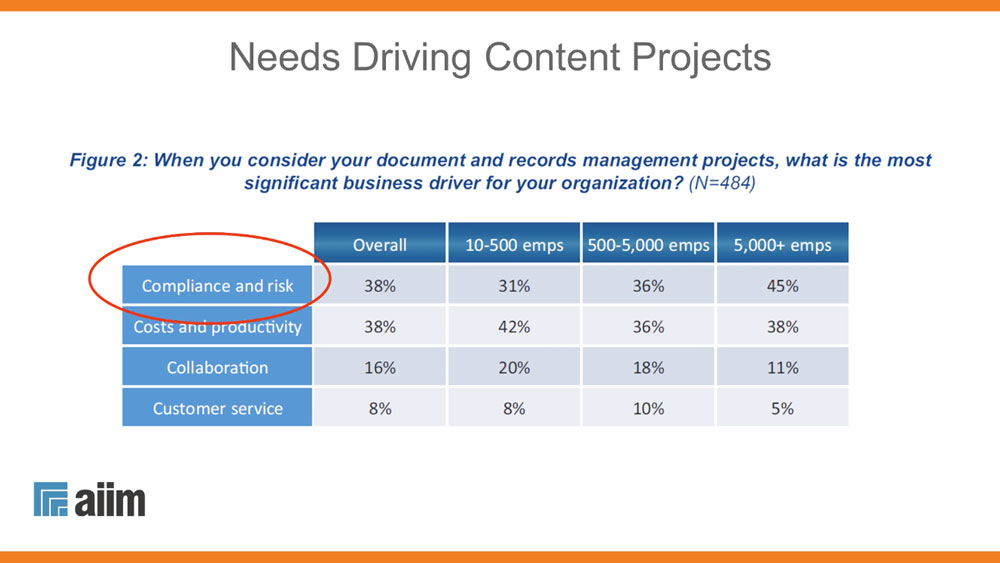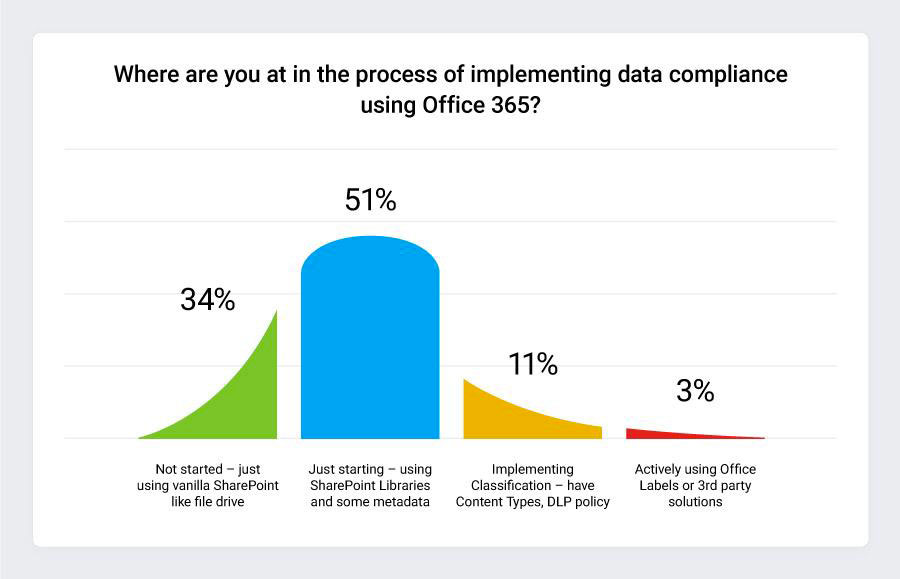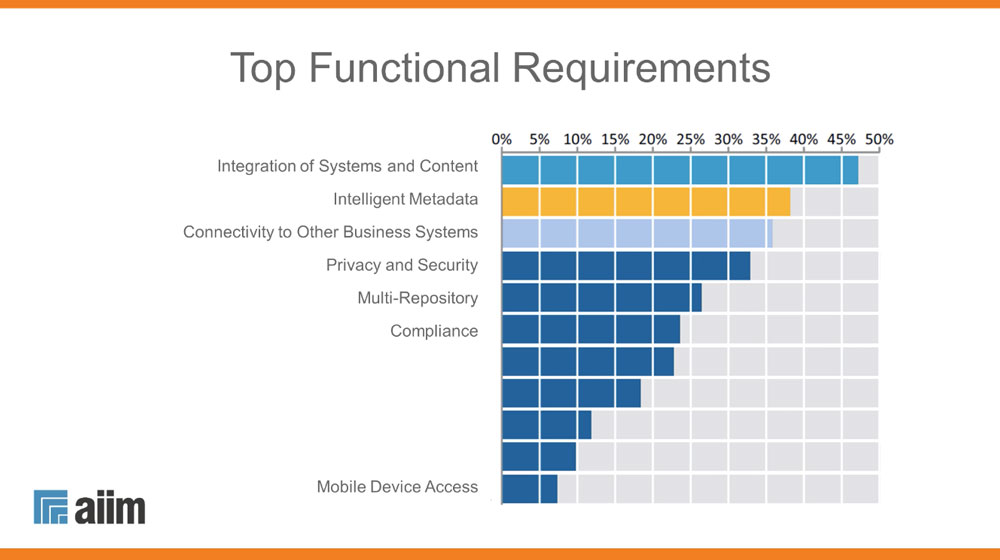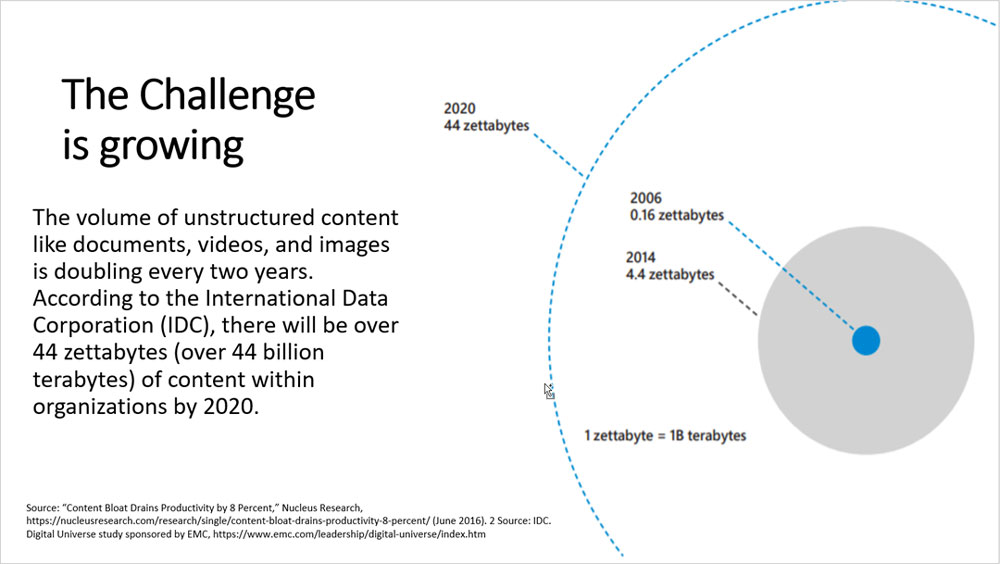Last Updated on July 17, 2019 Sarah Gayda
Two years ago, Colligo wanted to know what drove organizations to find ECM (Enterprise Content Management) solutions. We polled attendees during a Future of Enterprise Content Management webinar we did with AIIM and found that 38% said either compliance and risk, or costs and productivity were their key business drivers. Organizations faced the challenge of balancing those two objectives, and few had a data compliance strategy in place.

We interviewed Colligo Presale Engineer Roland Reddekop to ask what he sees next for ECM and Content Services. Drawing on lessons from the SharePoint Conference and experiences serving hundreds of organizations tackling knowledge management and information compliance, Roland offers four predictions for the future of content services and practical advice for organizations looking to take advantage of Microsoft’s evolving capabilities.
Q: In 2017, Gartner declared that ECM was “dead, kaput” and being replaced by Content Services. Where are we at today?
Roland Reddekop: Gartner’s death certificate for ECM was issued because the longstanding approach of ECM vendors to move all content into a central repository for management was no longer viable. Modern content is created and held in a wide variety of repositories and enterprises need to manage all content in place throughout the full lifecycle of knowledge and records management including document creation, sharing, consumption, reuse, archival and disposal. Gartner proposed a new term for this nimble, decentralized approach: Content Services. The term was quickly taken up by key vendors like Microsoft.
The Microsoft promise today is to equip businesses for end-to-end content management from creation, sharing and search minimum requirements for knowledge management, through to information compliance.
In the last few years Microsoft has developed an overall strategy and system of capabilities to invite organizations to manage content throughout Office 365, not just SharePoint. The Microsoft promise today is to equip businesses for end-to-end content management from creation, sharing and search minimum requirements for knowledge management, through to information compliance. With Office 365 retention and sensitivity Labels, organizations can classify content anywhere in the O365 universe. We’ve transcended the old centralized approach, and Microsoft Content Services strive to respond to both top business drivers: productivity and compliance, for the lowest cost.
Q: The full promise of Content Services and Office 365 are lofty – have you seen organizations seizing on those capabilities?
The shift is starting. Certainly, we are seeing evidence of more and more organizations adopting Office 365. We see it among our existing customer base, among progressive organizations that attend our webinars and in research by AIIM, Microsoft and MVPs in our network.
When it comes to Content Services compliance capabilities, there is incredible curiosity in the potential of utilizing O365 sensitivity and retention Labels, and how to get started, but few organizations have put Labels in place yet. We have readied ourselves for the compliance adoption wave we see coming. Colligo was first to market with Office 365 add-ins that let users save emails and documents into SharePoint with Labels. Developing those products has required us to think ahead about the compliance potential of Office 365.

On the knowledge management side, there is a continued strong demand for content services that help modern workers achieve greater productivity. My work focuses on making it easy to capture, tag and share information from Outlook and Office into SharePoint. The Content Services tools available are powerful. The key is to roll them out in a way that users want to use them.
4 Predictions for the Future of Content Services
Q: So, what’s next? How do you see Content Services addressing our modern data issues?
RR: There are five areas where I expect significant evolution in the next few years.
First – Microsoft will make it simpler to set up metadata.
Metadata isn’t new, but its power has yet to be fully realized. Back when we did our evolution of ECM webinar with AIIM, metadata was very top of mind. Microsoft dramatically improved metadata capabilities in SharePoint 2010 with the introduction of the Managed Metadata. Those services enabled hierarchical metadata tagging, allowed various content managers able to set terms, and centralized configuration of in one dashboard. Uptake was significant, but this function has fallen behind in usability and modern browser compliance.

At SP2019, Microsoft’s Content Service Team committed to upgrading their Content Types and Managed Metadata service. I cannot wait. Setting up metadata is one of the easiest entry points to better knowledge management for organizations. It’s great to see this in Microsoft’s development pipeline.
Second – Search will transcend applications, and get faster and faster.
Microsoft is aiming for One Search Box to Rule Them All – a universal tool across all of Office 365 that will help you find everything: emails, chats, resources on the web, and documents anywhere you store them, all from one top-centered search box.
RR: 20% of our work day is spent looking for information. That’s one day a week per employee. The ROI of improving the findability of data is huge. Search plus metadata is going to narrow down searches that rely on word-matches. Instead of Search getting you into the neighborhood of the content you’re looking for, you’re going to be able to refine keyword searches with metadata.
Search is transcending applications and getting better and faster. Microsoft is aiming for One Search Box to Rule Them All – a universal tool across all of Office 365 that will help you find everything: emails, chats, resources on the web, and documents anywhere you store them, all from one top-centered search box. I also anticipate search connectors will enable search across other repositories like legacy content systems, file systems, or social media.
Search results are also likely to evolve to deliver answers not just links. As you are seeing more and more with Google and Bing searches, search engines will be configurable to extract content excerpts in response to questions. When I search “Vacation Policy” or “Expense Mileage,” what I’m really looking for is a paragraph of instant guidance. Search will be able to extract that information.
Third – We’ll see next-generation data integration.
RR: Not all data that businesses wish to keep is in Office 365. There are plenty of repositories of company data, like Team conversations in Slack, Video libraries, Twitter posts and so on that are outside of Office 365. Companies are looking for a way to pull in and manage select content from diverse sources. I predict Content Services will expand to include Microsoft connectors to capture and manage data from outside sources to avoid letting that data go dark.
Fourth – AI driven auto classification will come of age.
RR: AI auto-classification of data is becoming ever more critical as data volumes grow and the majority of organization data is Dark Data – unstructured and untagged with metadata. Going through all that data manually to find the rare files of importance is too costly and time intensive to be feasible. AI will help companies mine through large sample of documents of a particular type – Contracts, for example – and learn the custom patterns that denote a contract in your organization. Then the trained classifier can do discovery across a larger and larger data pool to fine-tune the detection engine to precision.
Microsoft is making huge strides in AI auto-classification. Office 365 is already offering a premium auto-classification service for organizations with an E5 license and Microsoft predicts that machine learning will be able to classify 80% of corporate documents. The question is by when? We foresee it will take a few more years before AI classification can automate compliance without at least a human review and verification. We should ready for it, but not wait for it.
Driving Factors for Content Services Uptake
Q: What will be the catalysts of Content Services adoption?
RR: Foremost, I think the data explosion we are all experience will push diverse organizations to manage content differently. In 2018 they were saying that 90% of the world’s data was generated in the two years prior. There has been no slowdown in the volume of content generated – the only saving grace is that content is now almost entirely digital and Content Services tools exist to manage it.

Fuelling data volume is the advent of new content types. Consider chat in Microsoft Teams, and the prevalence of mostly unclassified video out there. There is a high likelihood that more of such formats will continue to strain the limits of conventional content management.
Alongside newcomer content types, email remains a major driver of content generation, and the largest factory of ROT (Redundant, Obsolete, Transient) content. Research shows that 80% of the business records that content compliance leaders are most determined to capture and classify are in email. Trouble is, 99% of what’s in inboxes isn’t a business record – that’s a lot of hay to dig through for needles. And most of us receive more and more email every day.
RR: I also sense a regulatory trigger event coming that will take compliance mainstream.
Research shows that 80% of the business records that content compliance leaders are most determined to capture and classify are in email.
I’m out on a limb here because I’m not a lawyer or regulator but when I talk with the legal and finance leaders working with Colligo on compliance projects, many are unsettled by the data breaches and cyberattacks they know about – only a fraction of which make mainstream news. Watching the frequency of data leaks rise, and the cost of reputation loss and legal fall out going up, it seems likely we are in only the early days of regulation of corporate information.
I expect, in the next few years, there will be new data protection regulation that suddenly makes implementing Advanced Data Governance including Labels “imperative this year.” Microsoft will be rewarded for making it easier than ever for organizations to advance their compliance with Office 365.
Key Considerations for Organizations
Q: Exploding data, intensifying compliance, demands for ever-increasing worker productivity. That’s a lot to juggle. What’s your advice to companies trying to prioritize their next step with Content Services?
RR: It can feel daunting, but remember the Content Services tools available today are designed exactly for these times. Here are a few quick practical bits of advice.
Start with your biggest problem.
For many it’s their wild west of inboxes. Companies need a good tool to make it easy for employees to move emails from Outlook into SharePoint right front their inboxes and with metadata and perhaps Labels. Our Colligo Email Manager is a quality tool for that task – and the only one that lets you extend into information compliance and Labels using the same tool favoured by workers for knowledge management. Whether your organization uses Office and SharePoint on prem or online with Office 365 – there is no more progressive way to tackle modern email management. Okay, off my soapbox now.
Tackle knowledge management and data compliance as a cross-functional team.
No surprise here. Companies that are successful at implementing Content Services for improved knowledge management and data compliance dedicate a project team and the necessary resources, to do it well. KM and IIM projects need expert leadership to understand both what’s practical for workers and what’s possible in SharePoint and Office 365. Short-cut including business users, content experts, and legal at your own peril.
Start and finish with a focus on users.
One of the most common factors in failed IT projects is neglecting the end user experience. In Content Services projects, you must combine a well-architected information approach, with a user interface that aligns with the way workers already work and streamlines their workload. Have users involved from the start, have them champion the approach, have them be the super user trainers. And if you get lukewarm response at any point – stop and resolve the resistance issue. User issues get more and more expensive as you roll out.
About the Author
Colligo supports intelligent knowledge management and compliance on SharePoint and Office 365 – all designed for users. Our complete email and document management solution helps organizations with diverse Microsoft environments to improve productivity and make data compliance practical. Colligo is a Microsoft Silver Application Development Partner and is proud to serve mid-sized organizations, Global 500 customers, and respected SharePoint and records management partners.





